I love oil companies. But I hate lying. Especially climate lying.
Oil companies have for years been telling the public that they are reducing CO2 emissions by storing CO2 underground when they inject it into wells to produce hard-to-reach oil. This process is called “enhanced oil recovery” or EOR. I showed the claim was false years ago. But no company would admit it.

Now thanks to my shareholder proposal (below) at ExxonMobil, I have forced an oil company to admit for the first time that its use of CO2 in EOR produces on a net basis more CO2 (when the oil is ultimately burned) than the amount of CO2 stored underground.
So, for example, if a conventionally produced barrel of oil produces 0.42 tons of CO2 when burned (per EPA), then an EOR-produced barrel of oil will produce 0.26 tons (per ExxonMobil) — versus the oil company propaganda that gives the impression that each ton of CO2 used in EOR reduced emissions by one ton. So EOR reduces emissions (vs. emissions for oil produced without EOR), but it does not offset emissions as implied/claimed.
Not only is this admission important to expose the false greenwashing claim, but US taxpayers are subsidizing oils companies for engaging in this con. Oil companies have used EOR for decades because it is economical. They shouldn’t be subsidized to do it for climate.
My proposal and ExxonMobil’s response is below. ExxonMobil’s admission is highlighted below.


When you look at CO2 sequestration without EOR, how does the CO2 produced when generating the energy to capture the CO2, pipe it to the storage facility, compress it and then pump it underground compare with the amount of CO2 actually stored (assuming the CO2 doesn’t leak)? Also, one should count the CO2 produced when building all the equipment necessary to capture, pipe and store the CO2, of course. Is there a general statistic that says one gets a “benefit” of a certain percent of the CO2 stored when one counts all this, maybe 50%?
Regardless of the math, I think the point you are making is that oil from EOR is NOT carbon negative when seen in a full life cycle perspective as the oil companies have apparently been claiming. It is not even carbon neutral. But, it does seem like EOR produced oil produces less CO2 emissions in its life cycle than conventional oil. Right?
I am asking these questions for an article I plan to write today so hope to hear back, svp.
Thanks,
Tom
http://www.icsc-climate.com
I do not understand the math here. Let’s say oil, conventionally produced or through EOR, produces X tons of CO2 per barrel when burned. But EOR absorbed Y tons of CO2 into the reservoir when a barrel of oil is recovered. So the actual amount, when seen in a complete life cycle, for EOR would be X – Y tons of CO2 emitted for each barrel of oil burned. So, it seems to me that you saying that X – Y = .63 times X, which would be 37% less than X.
But, if, on a life cycle basis, 63% of all the CO2 injected is your net savings of CO2 emissions when using EOR, wouldn’t X – Y = (1 – .63) times X , or 0.37 X. So, if a conventionally produced barrel of oil produces 0.42 tons of CO2 when burned, then an EOR-produced barrel of oil will produce 0.42 times 0.37 or 0.16 tons.
No comprendo.
I’ve done a lot of personal research around many “climate change” topics, but not on CCS. I did read some time ago that CCS (capture, compression, transport, etc.) required up to 30% of the energy produced by a coal-fired power plant. I don’t know how accurate that is or how it compares to other types of conventional generation. Regardless, it necessarily lowers the efficiency of power generation, that is, the net available to sell for a given amount of energy input. Is this accounted for in the calculation as shown in Steve’s 2016 article?
an oil company gaming the system, say it isn’t so!